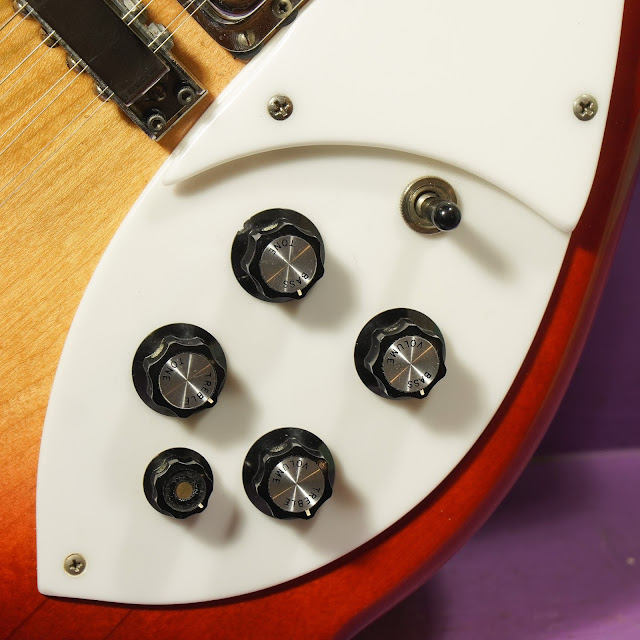1966 Rickenbacker 360/12 Fireglo Electric 12-String Guitar
Heart be still! Now, Rickenbacker 12-strings are phenomenal on their own. Fireglo finish is also a great look. But Fireglo on top of flamed maple? Oof! I also have a thing for Ricki gear that my wallet does not support. Do you know how long I've lusted after a 4005 bass, for example? Oh desires...
This one arrived here via a local consignor and sat-around until I could spruce it up. It needed a portion of the fretboard reglued and then the usual setup-side tweaking. Post-repairs it plays like an absolute champ, sounds as good (and as quirky!) as you'd expect, and it looks stunning. I mean -- when customers have come in the past couple days this is the instrument their eyes fly towards. How could it not be?
It's also all-original, quite clean, and fairly lightweight for its type, to boot. There's nothing to complain about. I'm smitten. Or, you could say, I've got "Fireglo" for it.
Quirks for the player, though? These have fast, thin necks -- with only a 1 5/8" nut width to squeeze all 12 strings in. The fretboard has a steeper radius, though, and the strings are spaced pretty closely together which makes this feel quite good. It feels like playing "a normal guitar" because of that -- just so comfy, especially for sliding and closed-poisition chords up and down the neck.
Another quirk? Tradition has these strung "backwards" from normal 12-string guitars, with the lower octave note before the higher octave one. This is how Greek bouzoukis are strung, too. I've maintained that tradition on this guitar (fat string first) and have also fully-compensated the original aluminum saddles to work with it, too, so it plays in-tune up the neck nicely. You cannot restring this for "octave first" stringing and have it play in tune well without altering the compensation at the saddles. Just a note. I had to alter the saddle tops anyhow, though, because they'd already been modified for compensation a little beforehand, so it wasn't sacrilege.
As per the usual, this guy works as a "mono" guitar or a "Rick-O-Sound" (stereo) guitar depending on what input you stick your jack in.
Repairs included: fretboard reglue (partial), fret level/dress, compensation/radius adjustment to the saddles, setup.
Body wood: sold maple (carved)
Bridge: adjustable
Fretboard: rosewood (thick)
Neck wood: maple multi-piece
Pickups: 2x original Rickenbacker
Action height at 12th fret: 1/16" overall (fast)
String gauges: custom 46w/20w, 36w/13, 26w/10, 17/8, 12/12, 9/9 low-to-high
Neck shape: slim C
Board radius: ~10"
Truss rod: adjustable (two of them!)
Neck relief: straight
Fret style: medium-lower
Scale length: 24 3/4"
Nut width: 1 5/8"
Body width: 15"
Body depth: 1 7/16"
Weight: 7 lbs 7 oz
Condition notes: everything is original on the guitar, though I did compensate the saddles. The nut is original but I re-aligned the string slots via sanding/reslotting as they were off-center. I kept the same spacing. The finish looks glorious throughout but it does have a teeny bit of light scratching on the center of the back and a heat-melt/chem reaction (often these are from straps) right below the heel on the back -- it's not too obvious but it's there, and pictured.
Otherwise there's only very light wear throughout, with a little wear to either side of the fretboard/neck seam from frets 1-4ish. Some of the reverse-paint lettering on the truss cover has attached itself to the headstock and off of the truss cover (parts of the ACK in the logo).
The tuner button rubs against the tuner housing just a hair on the D-string course.
It comes with: an original hard case and polishing cloth. Neat!

































Comments